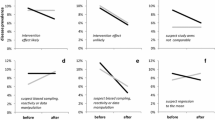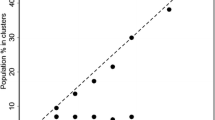Abstract
More and more citizens urge public health authorities to investigate reports of disease excess in their neighbourhood. These environmental concerns are legitimate and it is part of good public health practice to respond to these complaints. However, the methodological and practical problems are severe and a lot of controversy exists about the usefulness of these investigations. To clarify the possibilities and limitations in this situation, this paper proposes a typology of cluster studies. According to this framework, cluster response is distinguished from two other types of cluster studies: Cluster monitoring, screening proactively for clusters to act as an early warning system, and cluster research, scrutinizing clustering to generate and test aetiological hypotheses. To each of these three types of cluster studies corresponds a different public health context; respectively public health action, public health surveillance and public health research. Probably, part of the controversy mentioned stems from not acknowledging sufficiently the corresponding intrinsic differences in rationality and practical constraints. Cluster response is crisis management and not scientific research. In a relatively short time, an informed decision should be taken by a multidisciplinary team of experts using readily available information and knowledge. In accordance with this point of view, cluster reports should be handled stepwise and the role of statistics is to quantify a cluster exploring different points of view as an input to the decision process.
Similar content being viewed by others
References
Alexander FE, Cuzick J. Methods for the assessment of disease clusters. In: Elliott P, Cuzick J, English D, Stern R (eds), Geographical and environmental epidemiology. Methods for small-area studies. Oxford: OUP, 1992: 238–250.
Rothenberg RB, Thacker SB. Guidelines for the investigation of clusters of adverse health events. In: Elliott P, Cuzick J, English D, Stern R (eds), Geographical and environmental epidemiology. Methods for small-area studies. Oxford: OUP, 1992: 264–277.
Bender AP, Williams AN, Johnson RA, Jagger HG. Appropriate public health responses to clusters: The art of being responsibly responsive. Am J Epidemiol 1990; 132: S48–52.
Rothman KJ. A sobering start for the cluster busters' conference [see Comments]. Am J Epidemiol 1990; 132: S6–13.
Neutra RR. Counterpoint from a cluster buster. Am J Epidemiol 1990; 132: 1–8.
Wartenberg D. Should we boost or bust cluster investigations? [Editorial]. Epidemiology 1995; 6: 575–576.
Thacker SB, Berkelman RL. Public health surveillance in the United States. Epidemiol Rev 1988; 10: 164–190.
Cuzick J, Elliott P. Small-area studies: Purpose and methods. In: Elliott P, Cuzick J, English D, Stern R (eds), Geographical and environmental epidemiology. Methods for small-area studies. Oxford: OUP, 1992: 14–21.
Lilienfeld DE, Stolley PD. Foundations of epidemiology. 3rd ed. New York, Oxford: OUP, 1994.
Dolk H. The role of the assessment of spatial variation and clustering of birth defects in environmental surveillance. In: Anonymous EUROCAT Workshop on Clustering, 1997.
Day R, Ware JH, Wartenberg D. An investigation of a reported cancer cluster in Randolph, Massachusetts. J Clin Epidemiol 1989; 42: 137–150.
Eylenbosch WJ, Noah ND. Surveillance in health and disease. Oxford: Oxford University Press, 1988.
Lie RT, Vollset SE, Botting B, Skjaerven R. Statistical methods for surveillance of congenital malformations: When do the data indicate a true shift in the risk that an infant is affected by some type of malformation? Int J of Risk & Safety in Medicine 1991; 2: 289–300.
Anonymous. Congenital malformations worldwide. A report from the International Clearinghouse for Birth Defects Monitoring Systems. A Non-Governmental Organization of the World Health Organization. Amsterdam, New York, Oxford: Elsevier, 1991.
Jensen OM, Parkin DM, MacLennan R, Muir CS, Skeet RG. Cancer registration: Principles and methods. Lyon: IARC, 1991.
Elliott P, Martuzzi M, Shaddick G. Spatial statistical methods in environmental epidemiology: A critique. Stat Meth in Medical Research 1995; 4: 139–161.
Khoury MJ, Holtzman NA. On the ability of birth defects monitoring to detect new teratogens. Am J Epidemiol 1987; 126: 136–143.
Dolk H, De Wals P. Congenital anomalies. In: Elliott P, Cuzick J, English D, Stern R (eds), Geographical and environmental epidemiology. Methods for small-area studies. Oxford: OUP, 1992: 72–88.
Cornel MC, Erickson JD, Khoury MJ, James LM, Liu Y. Population-based birth-defect and risk-factor surveillance: Data from the Northern Netherlands. Int J of Risk & Safety in Medicine 1996; 8: 197–209.
Ten Kate LP, Cornel MC, de Walle HEK. Monitoring of risk factor/outcome combinations: A valuable supplement to birth defect monitoring. Int J of Risk & Safety in Medicine 1992; 3: 129–136.
Erickson JD. Risk factors for birth defects: Data from the Atlanta birth defects case-control study. Teratology 1991; 43: 41–51.
Khoury MJ, Botto L, Mastroiacovo P, Skjaerven R, Castilla E, Erickson JD. Monitoring for multiple congenital anomalies: An international perspective. Epidemiol Rev 1994; 16: 335–350.
Olsen SF, Martuzzi M, Elliott P. Cluster analysis and disease mapping — why, when, and how? A step by step guide. Br Med J 1996; 313: 863–866.
English D. Geographical epidemiology and ecological studies. In: Elliott P, Cuzick J, English D, Stern R (eds), Geographical and environmental epidemiology. Methods for small-area studies. Oxford: OUP, 1992: 3–13.
McCullagh P, Nelder JA. Generalized linear models. 2nd ed. London: Chapman and Hall, 1989.
Drijver M. Ziekteclusters in relatie tot milieuverontreiniging. In: Anonymous, Leiden: 1989: 1–25.
Chen R, Connelly RR, Mantel N. Analysing post-alarm data in a monitoring system in order to accept or reject the alarm. Stat Med 1993; 12: 1807–1812.
De Wals P, Niyonsenga T, Laguë J. [Investigation of cluster of adverse reproductive outcomes: Theoretical and practical aspects]. Arch Public Health 1996; 54: 43–58.
Wartenberg D, Greenberg M. Solving the cluster puzzle: Clues to follow and pitfalls to avoid. Stat Med 1993; 12: 1763–1770.
Jacquez GM, Waller LA, Grimson R, Wartenberg D. The analysis of disease clusters, Part I: State of the art. Infect Control Hosp Epidemiol 1996; 17: 319–327.
Jacquez GM, Grimson R, Waller LA, Wartenberg D. The analysis of disease clusters, Part II: Introduction to techniques. Infect Control Hosp Epidemiol 1996; 17: 385–397.
Wartenberg D, Greenberg M. Detecting disease clusters: The importance of statistical power. Am J Epidemiol 1990; 132: S156–66.
Waller LA, Jacquez GM. Disease models implicit in statistical tests of disease clustering. Epidemiology 1995; 6: 584–590.
Grimson RC, Wang KC, Johnson PWC. Searching for hierachical clusters of disease: Spatial patterns of sudden infant death syndrome. Soc Sci Med 1981; 15d: 287–293.
Grimson RC, Rose RD. A versatile test for clustering and a proximity analysis of neurons. Methods Inf Med 1991; 30: 299–303.
Knox G. The detection of space-time interactions. Appl Stat 1964; 13: 25–30.
Knox EG. Leukaemia clusters in Great Britain. 1. Space-time interactions. J Epidemiology and Community Health 1992; 46: 566–572.
Mantel N. The detection of disease clustering and a generalized regression approach. Cancer Res 1967; 27: 209–220.
Jacquez GM. Statistical software for the clustering of health events. Stat Med 1996; 15: 951–952.
Elliott P, Shaddick G, Kleinschmidt I, Walls P, Beresford J, et al. Cancer incidence near municipal solid waste incinerators in Great Britain. Br J Cancer 1996; 73: 702–710.
Author information
Authors and Affiliations
Rights and permissions
About this article
Cite this article
Quataert, P., Armstrong, B., Berghold, A. et al. Methodological problems and the role of statistics in cluster response studies: A framework. Eur J Epidemiol 15, 821–831 (1999). https://doi.org/10.1023/A:1007537813282
Issue Date:
DOI: https://doi.org/10.1023/A:1007537813282




